BT Trial Cloud Based C-RAN 5G Mobile Technology in Leeds UK UPDATE

BT Wholesale – supported by EE and Three UK – is conducting a new “state-of-the-art” 5G (mobile broadband) technology trial in Leeds, where they’re deploying a Cloud Radio Access Network (C-RAN) that in future could be installed as individual street works or fitted in existing street-furniture (e.g. lampposts) to extend the signal.
C-RAN, which is also known as Centralised-RAN, is an architecture for cellular networks that has actually been around for quite a few years. A traditional mobile network consists of many standalone base stations, each covering a small to modest area, which is costly to build and tedious to manage. By comparison, C-RAN harnesses cloud computing, making it easier to build, manage and deploy large scale centralised networks.
BT’s C-RAN project has seen the first units installed at key locations in Leeds city centre, which will allow the operator to track how the infrastructure improves access in the area and serve as a proof of concept for future developments. The infrastructure is currently being used by the EE and Three UK networks for the trial.
Advertisement
The C-RAN technology trial uses specialist software, which “has the potential to be used in smaller, more compact units, including existing street furniture“.
Alex Tempest, Managing Director, BT Wholesale, said:
“The introduction of this new technology highlights BT’s commitment to delivering innovative solutions that benefit residents, businesses, and visitors, whilst also supporting economic growth across Leeds and the wider UK.
This trial represents another step in transforming connectivity for the future and will help us better understand how 5G can best be delivered to meet the demands of the country.”
At present, this trial is still fairly small. The first three units are live in the city centre already, with a further three to follow in the “coming months“. The trial will partly focus on improving 5G coverage and faster speeds, although it could also be used to help “provide a platform for the city to access other community and business developments” (e.g. the creation of virtual classrooms, air quality and pollution monitoring, and improved support for assisted living).
UPDATE 10:22am
Added a picture from one of the trial poles / masts.
Advertisement
Mark is a professional technology writer, IT consultant and computer engineer from Dorset (England), he also founded ISPreview in 1999 and enjoys analysing the latest telecoms and broadband developments. Find me on X (Twitter), Mastodon, Facebook, BlueSky, Threads.net and Linkedin.
« ISP Community Fibre Gets £100m Funding Boost for UK FTTP Build





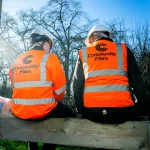


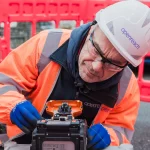


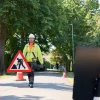

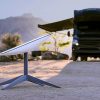

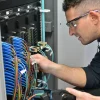






































That’s pretty great, hope it’s a success.
PS: queue anti-5G histericals when NR is coming on a lamp post near them..
That would be “cue” not “queue”, and I find when you explain that all current UK 5G installs are reusing existing frequencies for mobile, previously used for TV, or are “adjacent” to the frequencies used for WiFi/Microwave ovens etc. in the home then they have nowhere to go in the discussion.
As far as I know, there is no UK rollout of “Millimetric” frequencies for 5G yet (I believe there are rare specialist uses for that kind of wavelength that long pre-date use for 5G). Not that millimetric should be an issue when properly and safely installed (yes you might not want to headbut the aerials when operational, but that’s true of any significant RF power)
I hope it reduces congestion on the Three network in LS11, 4G plus is around 1 Mpbs during office hours.
I think it will appeal to the NIMBYs that the mast is a tad shorter and there are no/mimal wrap around cabs.
What is being virtualised? What exactly is C in this instance?
There are a few components that make up a mobile network, these usually are hardware devices plus some servers running some software. The “C” being cloud computing, allows the mobile network to shift whatever comes in from the actual masts into the all mighty cloud. Instead of a mobile network running servers for access, billing, provisioning, call routing etc it’s just all cloud based now. And, more often than not, not run by the mobile network itself but outsourced to the vendor.
@Victor Thanks. I understand the principle but it would be useful to understand what is now virtualised and what is not. Is the registration data now virtualised? e.g. That would help simply integration of mobile and services delivered over fixed broadband. How is the allocation of spectrum bands being managed?
https://en.wikipedia.org/wiki/C-RAN
You virtualise everything besides the physical radios themselves, and the radios can coordinate spectrum management between themselves across a control plane to optimise coverage and capacity.
Rather than having the digital / baseband equipment in a cabinet next to the mast it’s at the other end of some fibre alongside baseband for a bunch of other masts.
It’s basically the equivalent of going from having a bunch of processing at each mast to having it in a single datacentre for many masts, much as you would collapse a bunch of servers into VMs drawing on compute, storage and networking as resource pools shared across multiple physical hosts rather than fixed allocations at each server / mast.
@XGS thanks.
“By comparison, C-RAN harnesses cloud computing, making it easier to build, manage and deploy large scale centralised networks.”
Could someone please explain this in more understandable terms?
GNewtown, essentially it means the computing hardware can be run ‘in the cloud’ (read: in a big datacentre). Compare that to, for example, connecting to a centralised BT computer that could be hundreds of miles away.
There are a few quirks that C-RAN allows that can be advantageous. Depending on how you configure them.
In the old configurations, you may have individual networks of internet connected antennas. You can setup C-RAN with some fairly nifty new technology, for example the antennas may allow significant speed and latency improvements, faster rollout and the antennas may be able to talk to each other and distribute significant data/speed downloads. May also be simpler and allow software configuration of what would previously be a physical hardware installation/product (frequencies, comms, backup etc.).
@Aled: Thanks for explaining it, makes sense now.
Not sure if I would want these things stuck in a lamppost opposite me, not that it will happen,
I do however because there’s no medically proven evidence that 4G or 5G are bad for us despite how many times the anti 5G mob etc seem to believe.
If this means better network coverage than it’s a good thing and the sooner it’s available everywhere the better.
Surly having high energy transmitters so close to people’s homes is not good, there is no proof that it is not harmful. The other thing is interference, if a bunch of Christmas lights over the road can cause problems with broadband, then what is to stop these masts doing the same thing but with other devices?
Thankfully it will not happen here, as there is no need to,
They aren’t high energy transmitters. You’re bathed in far higher energy from terrestrial TV transmitters, regular radio transmitters and, indeed, the sun. Your WiFi and leakage from your microwave oven both put more energy into you than a mobile mast nearby would.
The harder core mobile masts chuck out 120 watts. Emley Moor was transmitting analogue video at 870,000 watts. BBC radio was getting blasted out at over 100,000 watts by some transmitters.
They’re only a cause of interference to Virgin Media cable at the lower end for the same reason TV transmissions don’t break your VDSL broadband: different spectrum.
You really, really, could do worse than not dabbling in the conspiracies you seem to repeat here and on the other place.
On the matter of harm there’s plenty of proof it’s not harmful. Again stop reading the conspiracy theory nonsense. We’re quite familiar with the difference between ionising radiation, radiation with enough power that it’ll strip electrons from atoms causing DNA damage in living cells, and non-ionising radiation, as used on TV broadcasts, mobile networks, etc. If non-ionising were a problem we’d have seen a lot of sick people around the area of the near-megawatt broadcast towers that dotted the countryside before they had their power reduced as they went digital. We don’t.
If you shove your face next to a transmitter of a microwave link that has enough power, and basically none do, it’ll have a similar effect to shoving your head in a microwave oven, you’ll warm up and your head will boil. That’s why those aren’t at ground level. If you’re just receiving some milliwatts from a regular transmitter, remember the transmit power is distributed across a wide area and you’re in a small fraction of that area so only get a fraction of the power, it’ll make a very marginal difference to the temperature of your skin, way less than being in sunlight, and that’s all.
Being in sunlight is harmful however it’s the ultraviolet that gets you. The visible and infrared spectrums, it’s infrared that warms you, don’t cause cancer so aren’t filtered by sun cream. The 5G transmissions are way below infrared in frequency, it starting around 300,000,000,000 Hz. Ultraviolet starts at around 750,000,000,000,000 Hz. This stuff is in the 700,000,000 Hz to 2,700,000,000 Hz range. It doesn’t have the energy to knock electrons out of atoms and cause DNA damage.
@XGS Is On, I understand what you are saying and I do know about frequencies, but I would still prefer it not to be so close. It makes no difference here, as it will not happen anyway. As for mobile masts, most of them are not on your doorstep, granted the one by the football ground is on people’s doorstep, but it is above head high.
I think this trying to get 5G to every nook and cranny is getting stupid, 4G or 3G for that matter never needed all these masts hidden in lampposts. Just shows that not all technology is better than the old
A similar deployment has already been started by Three in Birmingham.
There is a youtube video with the deployment, the install in leeds looks very similar… https://www.youtube.com/watch?v=0LcvyBX8Qv8
@ MilesT
In fact Millimeter-wave (mmW) frequencies (30–300 GHz) are being used and have been used for over a decade for many applications. These applications include, radio astronomy, remote sensing, automotive radars, military applications, imaging, security screening (body scans), and telecommunications.
If anything it’s becoming crowded, but there is huge bandwidth available.
Amateur Radio worldwide has allocations in mmW bands too inc – 6 mm (47 GHz), 4mm (76 GHz), <2 mm (134 and 247 GHz) I'm an Advanced op of some 30 years and know people who experiment in these massive bandwidth allocations.